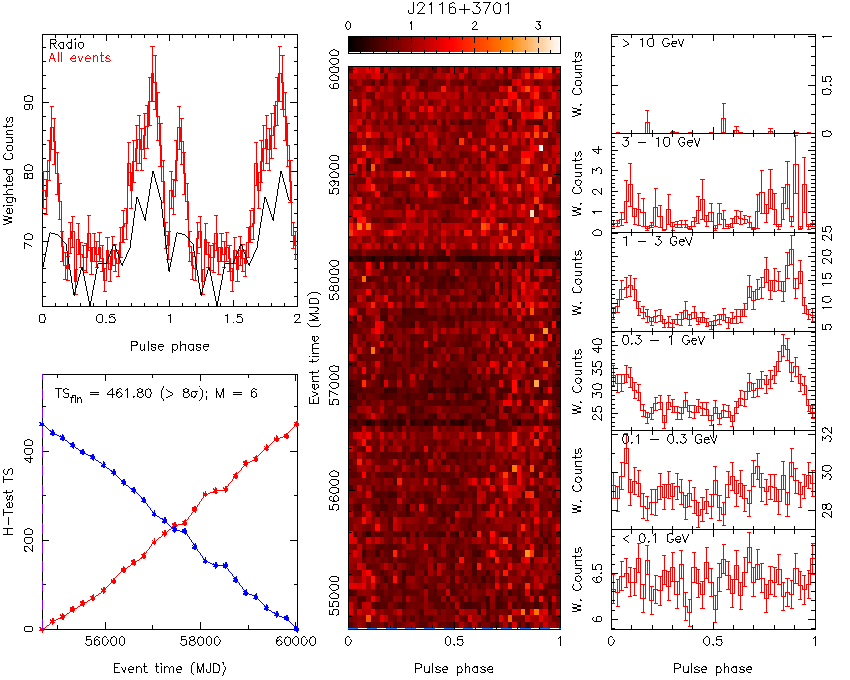General Information
----------------------------------------------------------------------------------------------
PSRJ RAJD DECJD P0 DIST EDOT
(deg) (deg) (s) (kpc) (erg/s)
----------------------------------------------------------------------------------------------
J2116+3701 dcm+23 319.059600 37.025314 0.14588 dcm+23 2.903 6.7e+34
G100: 5.5e-12 +/- 9.7e-13 erg/cm2/s
LumG: 5.5e33 +/- 1.e32 +/- (3.5e33, 5.3e33) erg/s
EffG: 0.082 +/- 0.015 +/- (0.053, 0.079) (EffG = LumG/Edot) (first uncertainty is statistical, second includes the distance uncertainty)
Here is the closest 4FGL source:
name angSep gglon gglat (maj,min95) Sigma nickname
4FGL J2116.2+3701 0.000 82.3045 -8.3410 (0.077, 0.063) 14.4 P88Y5920
Codes (see bottom of page): R r.
ATNF psrcat v1.70 includes dcm+23 -- https://ui.adsabs.harvard.edu/abs/2022arXiv221009172D/abstract The second set of pulsar discoveries by CHIME/FRB/Pulsar: 14 Rotating Radio Transients and 7 pulsars Dong, Fengqiu Adam ; Crowter, Kathryn ; Meyers, Bradley W. ; Pleunis, Ziggy ; Stairs, Ingrid ; Tan, Chia Min ; Yu, Tinyau Timothy ; Boyle, Patrick J. ; Cook, Amanda M. ; Fonseca, Emmanuel ; Gaensler, Bryan M. ; Good, Deborah C. ; Kaspi, Victoria ; McKee, James W. ; Patel, Chitrang ; Pearlman, Aaron B.
We noticed that the position of PSR J2116+3701 closely matches that of the 4FGL source listed above and on the SED below, where 4FGL is the Incremental Fermi Large Area Telescope Fourth Source Catalog Abdollahi, S. et al. 2022ApJS..260...53A
That source is non-variable (unlike most blazars) and has the pulsar-like SED shown below:
From the Table in dcm+23 we created J2116+3701.par and we gamma-ray phase-folded the Fermi LAT data using the methods described in Searching a Thousand Radio Pulsars for Gamma-ray Emission Smith, D. A. et al. 2019ApJ...871...78S . We thank dcm+23 lead author Fengqiu Adam Dong for having sent us the .par, the radio pulse profile to overlay on the gamma-ray phase histogram, and for other useful exchanges. This first folding gave an Htest of 66 for >14 years of LAT data, with a peak near 160 about 2000 days before the beginning of the radio ephemeris validity.
We then used the methods of Precise γ-Ray Timing and Radio Observations of 17 Fermi γ-Ray Pulsars Ray, P. S. et al. 2011ApJS..194...17R to create gamma-ray times-of-arrival, refit the ephemeris using the tempo2 "plk" plugin, to obtain an Htest of 375.
Applying the methods of Timing gamma-ray pulsars with the Fermi Large Area Telescope: Timing Noise and Astrometry Kerr, M. et al. 2015ApJ...814..128K and using Model Weights as per Extending the event-weighted pulsation search to very faint gamma-ray sources Bruel, P. 2019A&A...622A.108B finally gave Htest 461 for the full data set, as shown below.
Nota bene! We are currently (3 May 2023) verifying the radio-gamma phase alignment. What is shown below is quite possibly wrong, contact us if you need confirmation.
Pulsar History and Characteristics codes:
'G' 'Discovered in Fermi-LAT gamma-ray data.'
'R' 'Discovered in the radio and/or gamma-ray pulsations detected using the radio ephemeris.'
'X' 'Discovered in the X-ray and/or gamma-ray pulsations detected using the X-ray ephemeris.'
'E' 'Pulsar was detected in gamma rays by EGRET/COMPTEL.'
'P' 'Pulsar was discovered by the Pulsar Search Consortium.'
'U' 'Discovered using a Fermi-LAT seed position.'
'r' 'Pulsations detected in the radio band.'
'x' 'Pulsations detected in the X-ray band.'
'm' 'Millisecond pulsar.'
'b' 'Pulsar is in a binary system.'
'w' 'Pulsar is in a black-widow system.'
'k' 'Pulsar is in a redback system.'
'q' 'Gamma pulsar with no radio detection'


3 Comments
Paul Ray
My only comment is that the formatting in the General Information section is a little hard to parse and some bits not really explained (e.g. what is "Index"?)
David A. Smith
Thanks. I tidied it up a bit. And deleted the 4FGL catalog index number, which indeed is unhelpful.
Paul Ray
Cool. I made a couple little edits after yours.